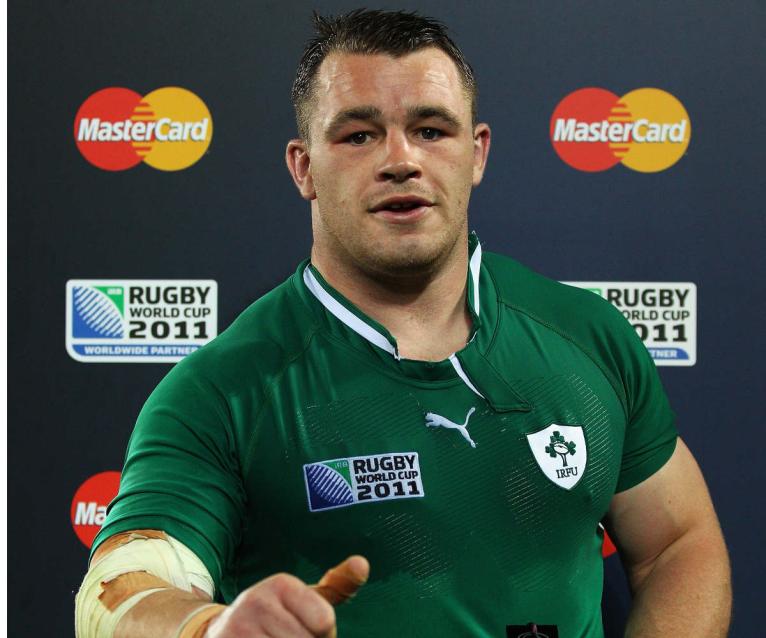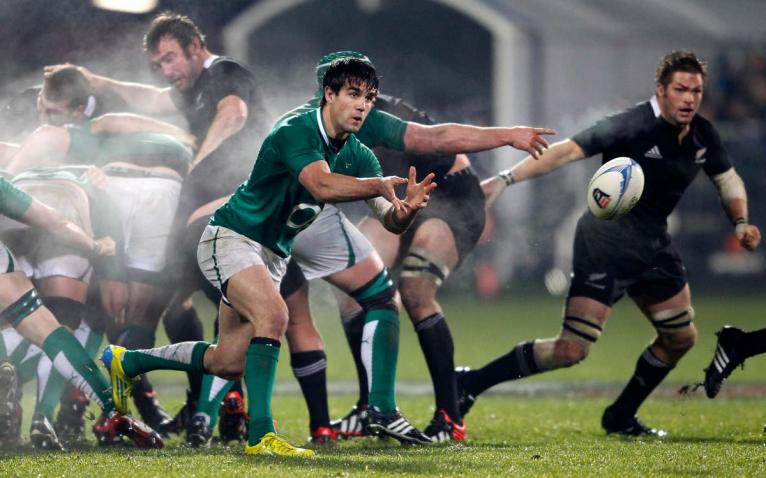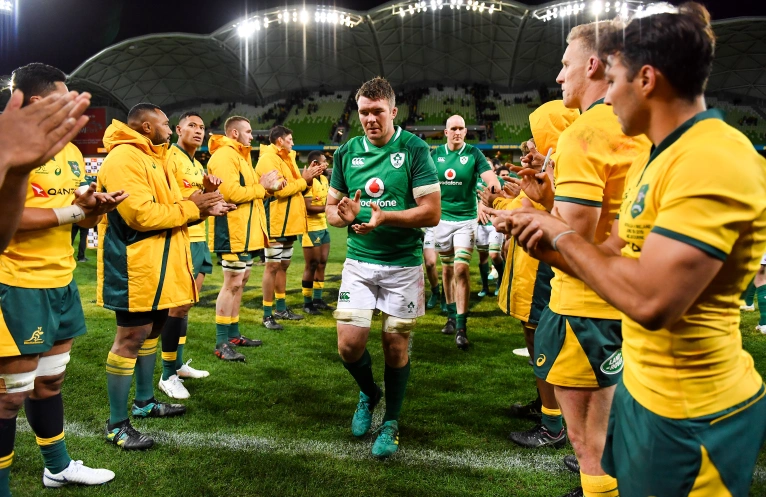A triple retirement is looming for the Ireland team as three men that have earned living legend status prepare for their final Six Nations games. Depending on how Ireland fare against France, Peter O’Mahony, Conor Murray and Cian Healy may not be seen again, in green, after that Dublin denouement.
Ireland, through Andy Farrell and Simon Easterby, have not figured out what life after O’Mahony will be, yet. He will be missed most, and is likeliest to start against France. Murray and Healy have been firmly in their ‘closer’ roles for the past few seasons and although the Aviva Stadium will reverberate when they make their entrances and exits, sentimentality is not coming into it. Ireland are chasing their fifth Grand Slam in Six Nations and all three will have parts to play. That says all that you need to know.
When news came through of their impending retirement from international rugby, with Ireland, thoughts turned to defining Test match moments. O’Mahony playing on the wing against Italy, his try-saving intervention to deny Ben Smith, ‘sweet-sledging’ Sam Cane in Dunedin, and seeming to be right in the middle of every flare-up against the Welsh and Scots. Healy almost ejecting Quade Cooper from Eden Park, ploughing through Mike Phillips in Cardiff and using Richie McCaw as a doormat in Dublin. Murray, master of the booming box-kicks, his inch-perfect chip that put it on a plate for Tommy Bowe against South Africa, leaving Aaron Smith for dead at Soldier Field, then stepping up to kick a penalty against the All Blacks as Johnny Sexton was hobbling.
In terms of games that set each man on the road to legendary status, that was simple. These are the matches that stood out.
Cian Healy vs. Australia, 2011 World Cup, Eden Park
Ireland went into their seventh World Cup without ever having taken a major scalp. Declan Kidney’s side had claimed a Six Nations Grand Slam in 2009 but their entire front row from that campaign was changed. Marcus Horan and John Hayes were not in New Zealand. Jerry Flannery was part of the squad but got injured in the opener, against the USA, and would not play for Ireland again.
Heading into that Pool C game in Auckland, it had been 32 years since Ireland had beaten the Wallabies away from home. Robbie Deans’ pack had fronted up well against New Zealand and South Africa in their successful Tri-Nations campaign, heading into the tournament. Still, Kidney fancied Ireland could get after the Aussies in the scrum. So did Flannery. In tears, the night before the game, Flannery did as Kidney requested and presented jerseys to the match-day 22. When Healy approached, Flannery fixed him with those glassy, blue eyes, shook his hand and urged the 23-year-old ‘go after them’.
Healy did not need a second invitation. At Eden Park, he announced himself to the wider rugby world with a display of awesome power. He helped Ireland stave off early Australian pressure with a thumping tackle on Tatafu Polota-Nau. Minutes later, he pounced for a turnover after Paul O’Connell had brought James Horwill to ground.

Packing down in a front row with Rory Best and Mike Ross, Healy eviscerated the Wallabies scrum. He did concede an early penalty when his bind slipped on Ben Alexander. After that, the Leinster loosehead was flawless. The Irish scrum won five penalties that night, two of which were despatched by Ronan O’Gara to grow their lead. Most people connect that game with Stephen Ferris hoisting Will Genia off his feet and marching him back towards the West Stand. Healy pulverising Quade Cooper, as he tried to run the ball out of his 22, is a close second. The technique is perfect – tracking back to get side-on and driving up in the tackle so that his left shoulder catches the arm of Cooper, knocking the ball loose. Radike Samo juggles, Kurtley Beale gathers and tries to chip but there Healy is, again, swatting the ball so Best can gather. The Kiwi commentators are practically purring as replays loop.
We marvel, today, at Andrew Porter playing beyond 70 minutes. Rightly so, as it is an impressive feat. In his early years with Ireland, Healy would often go the full 80. Such was the case at Eden Park, back in 2011. Fittingly, he came up with the final turnover of the game as he pinned Rob Simmons and won a penalty – his buddy, Jamie Heaslip celebrating on the deck, with him, as the whistle blows. 20 years after Michael Lynagh broke hearts in with a late try in Dublin, Ireland were finally on the World Cup map.
I remember walking along the concourse, back to the media centre, when Healy’s face flash up on the big screen for his Man of the Match interview. The place erupted, all over again.
“It felt good to dominate the Australia scrum,” Healy declared. “It’s always nice to get on the front foot and load the pressure on… We’d been working hard at scrummaging and we knew it was coming.”
Conor Murray vs. New Zealand, Rugby League Park, 2012
Touring sides to New Zealand could fill a bookcase with woes of the early gut-check that is usually served up at Eden Park. Ireland’s tour to the Land of the Long White Cloud, in 2012, was no different.
I can still recall sitting with a clutch of travelling Irish writers, at The Spencer Hotel in Takapuna, around breakfast time on the day Declan Kidney announced his team for the First Test. Kidney was giving us the team in advance, and under embargo, so we could make the next day’s newspapers, back home.
Each of his picks, and reasonings, made sense. Kidney was making some ballsy calls – O’Mahony at blindside and Simon Zebo on the left wing. Both were only 22, and this would be Zebo’s debut. They were two of four Munster players in the starting XV. Brian O’Driscoll wore 13 for the game but would actually play inside centre, with Keith Earls outside him. Declan Fitzpatrick and Dan Tuohy’s form with Ulster, and in training, merited their starting roles, Kidney argued. We nodded along.
Two days later, Ireland were slaughtered at Eden Park. They lost 42-10 and several international careers faltered. The following Saturday, at Rugby League Park in Christchurch, Murray and Ryan were the only Munster players left standing. Kidney ripped up ‘Plan A’ and handed starts to 13 of the players that had contested that season’s Heineken Cup Final, at Twickenham (10 Leinster, three Ulster).
Murray cut his teeth in New Zealand, the previous year, as a World Cup bolter. Eoin Reddan was in fine form with Leinster but Kidney recognised Murray as a player that could reign for a decade as Ireland’s No.9. This tour proved him right.

On a night that was as cold as it was damp, the 23-year-old took his game to the next level. Right where he wanted to be. On 10 minutes, he opened the scoring with a try that captured the ease at which he operated in rarified air. Ryan claimed a five-metre lineout throw and Ireland pulsed towards the All Blacks’ tryline. Their driving maul was eventually toppled, inches away. Carriers peeled back and made themselves available, to his left. For 10 ticking, tocking seconds, Murray held fire. The scene was mobbed but he waited until Sexton sprinted right, drawing the gaze of Aaron Smith and Julian Savea. Bang, Murray sniped. He feinted a pass to Sexton and cut back in, wrong-footing Tony Woodcock, and there was little Kieran Read could do either.
What elevated this Murray game, as he tormented the Kiwis, was the duel within a duel with Smith. The match teed up the duo fighting for world’s best 9 for the rest of the decade (Faf de Klerk would eventually crash that party). Smith responded with a try of his own, and both men were on alert to stop the other on threatening darts.
Murray’s tackling was technically excellent, throughout, as he brought down a charging Adam Thomson, early on, and dived to win loose ball inside his 22. His steepling box-kicks and clearances, which would become his stock-in-trade, mercilessly landed on Savea, all night. The winger struggled for clean takes as the ball returned from orbit, but he was not the only Kiwi forced into handling errors.
Reddan replaced him for the final 15 minutes. At 19-19, Ireland looked set to end what was then a 107-year wait for Test success against New Zealand, particularly when Israel Dagg was sin-binned. Sexton would miss the resulting, long-range penalty, Nigel Owens would penalise a surging Ireland pack, Dan Carter would get two bites at a drop goal and the All Blacks would win. At full-time, local rugby correspondents patted Irish counterparts as they shuffled and squeezed out of media row. “You deserved to win that.”
There was a Hamilton horror show to close out the tour, a week later, but Christchurch was the beginning of what has become a wonderful rivalry. It was the game when Murray announced himself as world-class, too. So he would remain for another 10 years.
Peter O’Mahony, AAMI Park, Melbourne, July 2018
This match arrived more than six years after O’Mahony had made his Test debut. He already had two Six Nations winners’ medal to his name. Melbourne was the city, however, that kicked off the second phase of his Ireland career, proved his captaincy credentials, and saw him neutralise Australia’s best player of the past 15 years.
The Cork native was in the form of his life, at the 2015 World Cup, when his knee popped in a pool stage win over France. That victory had seen Ireland top their pool, but at the cost of O’Mahony, Sexton and O’Connell (Sean O’Brien would also be suspended for striking Pascal Papé). Doctors and physios at the Millennium Stadium, that night, were flat-out. O’Mahony recalled one medic telling him his anterior cruciate ligament was in good shape. Sexton overheard otherwise and set him straight – ‘Sorry, kid. Your ACL is gone’.
O’Mahony missed the rest of that 2015/16 season. By the time he was back playing with Munster, Joe Schmidt had rejigged his Test back row. When Ireland finally defeated New Zealand for the first time, at Soldier Field, CJ Stander was wearing 6 and Josh van der Flier was on the replacements bench. It took until the 2017 Six Nations, and Heaslip’s back seizing minutes before kick-off to change everything. O’Mahony was promoted from the bench to start against England. He was named Man of the Match, England were denied a Grand Slam in Dublin, Warren Gatland’s attention was seized and he made the British & Irish Lions squad. He would feature in only one Test – Eden Park proving a happy hunting ground for New Zealand, again – but had the honour of leading out the Lions as captain.
The following season was the best O’Mahony ever had. He never looked better and caused pure chaos for opponents. He was a key part in Ireland’s third Grand Slam success and generously gave his winners’ medal away to travelling super-fan Donna Malone.

That summer, though, the Wallabies were waiting. Boasting a back-row of Michael Hooper, Caleb Timu and David Pocock – and with a 6:2 bench split – the Aussies went after Ireland at the breakdown. Hooper was a pest but Pocock was virtually unstoppable. The Brumbies openside had an astonishing 56 ruck involvements and made 15 poach attempts on Irish ball. Pocock had four turnovers and, when he was denied, slowed Irish distribution to treacle. It was a masterclass. To cap it off, he dived over for the match-winning try in the final minutes.
Former Ireland lock Neil Francis, penning his thoughts for a national publication, bemoaned Pocock as ‘a cancer on the game’. It sparked a fiery reaction from Wallabies coach Michael Cheika, before O’Mahony put the matter to bed. “I certainly don’t think that’s the opinion we, as a group, or as a nation have of David,” he stated. “He’s an incredible rugby player – you saw the impact on the game he had last week, and I certainly wouldn’t be standing by a comment like that.”
If that diplomatic fire was doused, O’Mahony lit one under Pocock for the Second Test. In training, Tadhg Beirne mimicked the Aussie in training drills and Ireland brought the heat to Melbourne. This, for me, was O’Mahony’s most impressive Test match. Named at blindside but operating as an openside in defence, he blasted Pocock out of six rucks and had three breakdown turnovers of his own. On the second and third of those, the whistle shrilled as O’Mahony latched on while three green and gold torsos, each time, contorted around him.
“He was tremendous, just so physical around the breakdown,” Stephen Ferris would observe, on Sky Sports. “He kind of ‘out-Pococked’ Pocock on the day… He led from the front. Pete might not be this really natural athlete, getting across the gainline and making huge big carries, but he brings experience, he brings a lot of leadership in the crucial times that we talk about and he was right in the middle of them today.”
Cheika shifted Pocock to No.8 for the deciding Test, after that Ireland victory. Schmidt did not even pretend any more and O’Mahony was handed the 7 jersey. Sydney was another war, with Hooper only lasting 15 minutes and O’Mahony off with concussion before half-time. Pocock was still dangerous – he always was – but proved human, after all.
“Happy days,” O’Mahony signed off the trophy presentation, on FOX Sports. Ireland closed out the series with a 20-16 victory. Standing in for the injured Rory Best, on that tour, it would be the first trophy he would win as captain in the professional game.
Six years later, he had the honour of lifting the Six Nations trophy as permanent Ireland captain. He never needed titles, though. He always just led, no matter what.
News, stats, live rugby and more! Download the new RugbyPass app on the App Store (iOS) and Google Play (Android) now!



Great article.
Murray’s game against the AB’s in Solider Field has to be the best 80 min performance from a #9 at test level. He ran the show. Not just the win but in putting 40 PTS on them.
The try, the penalty, his tempo and box kicking. Running 70 metres to empty Savea and set up the game wining 5 metre scrum.
He was unplayable and eclipsed even peak O’Driscoll.
Cheers Teddy. Yeah, he was a sensation that day. That tackle on Savea summed up what Ireland were all about, that day.
Conor Murray looks so young